
A honeycomb is a mass of hexagonal prismatic cells built from beeswax by honey bees in their nests to contain their brood and stores of honey and pollen.

A beehive is an enclosed structure in which some honey bee species of the subgenus Apis live and raise their young. Though the word beehive is used to describe the nest of any bee colony, scientific and professional literature distinguishes nest from hive. Nest is used to discuss colonies that house themselves in natural or artificial cavities or are hanging and exposed. The term hive is used to describe an artificial/man-made structure to house a honey bee nest. Several species of Apis live in colonies. But for honey production, the western honey bee and the eastern honey bee are the main species kept in hives.
Beekeeping is the maintenance of bee colonies, commonly in artificial beehives. Honey bees in the genus Apis are the most commonly kept species but other honey producing bees such as Melipona stingless bees are also kept. Beekeepers keep bees to collect honey and other products of the hive: beeswax, propolis, bee pollen, and royal jelly. Other sources of beekeeping income include pollination of crops, raising queens, and production of package bees for sale. Bee hives are kept in an apiary or "bee yard".
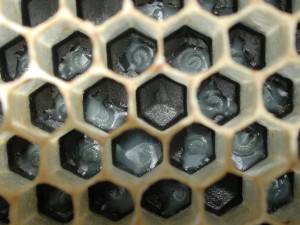
In beekeeping, bee brood or brood refers to the eggs, larvae and pupae of honeybees. The brood of Western honey bees develops within a bee hive. In man-made, removable frame hives, such as Langstroth hives, each frame which is mainly occupied by brood is called a brood frame. Brood frames usually have some pollen and nectar or honey in the upper corners of the frame. The rest of the brood frame cells may be empty or occupied by brood in various developmental stages. During the brood raising season, the bees may reuse the cells from which brood has emerged for additional brood or convert it to honey or pollen storage. Bees show remarkable flexibility in adapting cells to a use best suited for the hive's survival.
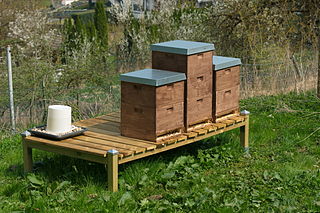
In beekeeping, a Langstroth hive is any vertically modular beehive that has the key features of vertically hung frames, a bottom board with entrance for the bees, boxes containing frames for brood and honey and an inner cover and top cap to provide weather protection. In a Langstroth hive, the bees build honeycomb into frames, which can be moved with ease. The frames are designed to prevent bees from attaching honeycombs where they would either connect adjacent frames, or connect frames to the walls of the hive. The movable frames allow the beekeeper to manage the bees in a way which was formerly impossible.

Comb honey is honey intended for consumption by humans, which is still contained within its original hexagonal-shaped beeswax cells, called honeycomb. It has received no processing, filtering, or manipulation, and is in the state that honey bees have produced it.
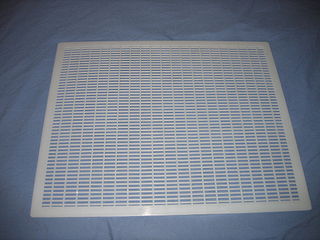
In beekeeping, a queen excluder is a selective barrier inside the beehive that allows worker bees but not the larger queens and drones to traverse the barrier. The bars have a distance of 4.2 millimeters. The barrier grid was probably invented around 1890.

A hive frame or honey frame is a structural element in a beehive that holds the honeycomb or brood comb within the hive enclosure or box. The hive frame is a key part of the modern movable-comb hive. It can be removed in order to inspect the bees for disease or to extract the excess honey.

A honey extractor is a mechanical device used in the extraction of honey from honeycombs. A honey extractor extracts the honey from the honey comb without destroying the comb. Extractors work by centrifugal force. A drum or container holds a frame basket which spins, flinging the honey out. With this method the wax comb stays intact within the frame and can be reused by the bees.
Hive management in beekeeping refers to intervention techniques that a beekeeper may perform to ensure hive survival and to maximize hive production. Hive management techniques vary widely depending on the objectives.
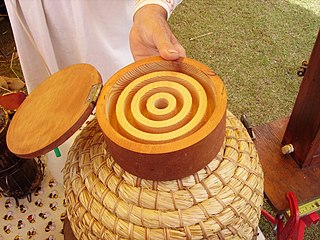
A feeder is a vessel or contraption used by beekeepers to feed pollen or honey to honey bees from a honey bee colony.

Lorenzo Lorraine Langstroth was an American apiarist, clergyman, and teacher, and considered to be the father of American beekeeping. He recognized the concept of bee-space, a minimum distance that bees avoid sealing up. Although not his own discovery, the use of this principle allowed for the use of frames that the bees leave separate and this allowed the use of rectangular frames within the design of what is now called the Langstroth hive.
The Stewarton hive is a type of historical bee hive. Extra boxes below allowed expansion of the brood, and thus strongly inhibited swarming and any tendency for the queen to enter the honey boxes, while expansion with extra honey boxes above the brood area gave ample space for the bees to create surplus honey stores that were easily harvested by the beekeeper. The introduction of this hive is credited to Robert Kerr, of Stewarton, Ayrshire, in 1819.
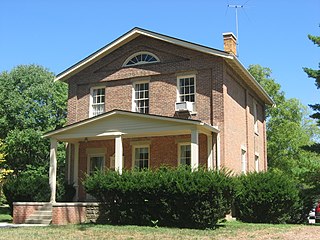
Langstroth Cottage is a historic building on the Western College campus of Miami University in Oxford, Ohio. It was designated a National Historic Landmark on June 22, 1976. The cottage, built in 1856, is now the home for the Oxford office of the Butler County Regional Transit Authority. It was purchased for Beekeeper L. L. Langstroth in 1859, and he lived there for the next 28 years, conducting research and breeding honey bees.

Honey extraction is the central process in beekeeping of removing honey from honeycomb so that it is isolated in a pure liquid form.
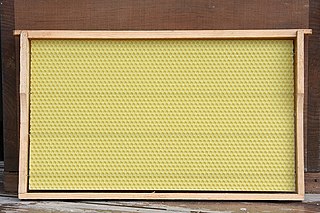
Wax foundation or honeycomb base is a plate made of wax forming the base of one honeycomb. It is used in beekeeping to give the bees a foundation on which they can build the honeycomb. Wax foundation is considered one of the most important inventions in modern beekeeping.
Honey bee starvation is a problem for bees and beekeepers. Starvation may be caused by unfavorable weather, disease, long distance transportation or depleting food reserve. Over-harvesting of honey is the foremost cause for scarcity as bees are not left with enough of a honey store, though weather, disease, and disturbance can also cause problems. Backyard beekeepers face more colony losses in the winter than in the summer, but for commercial beekeepers there is not much variation in loss by season. Starvation may be avoided by effective monitoring of hives and disease prevention measures. Starvation can amplify the toxic effect of pesticides bees are exposed to.

Flow Hive is a brand of beehive with a unique honey frame, which allows honey extraction without opening the beehive. During extraction, bees are visibly disturbed less than by other methods.

A hive tool is a handheld multipurpose tool used in maintaining and inspecting beehives. Hive tools come in multiple variants and styles, and is intended as an all-in-one tool for beekeepers.

Franz Hruschka, Franz von Hruschka, Francesco De Hruschka, František Hruška was an Austrian/Italian of Czech origin officer and beekeeper known as the inventor of the honey extractor, an invention he presented in 1865 at the Brno Beekeeper Conference.


















